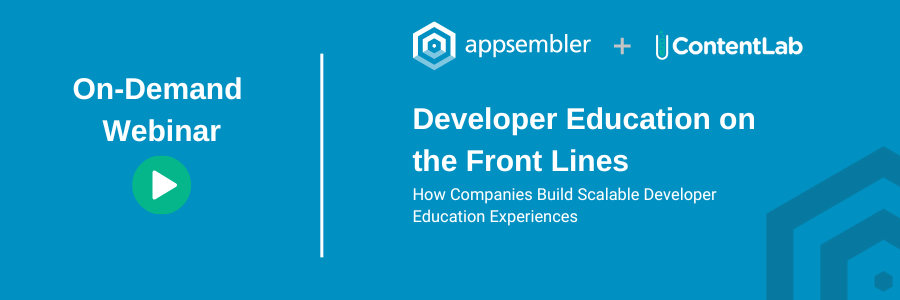Developer marketing is no longer in its adolescence; it’s now growing up. Experts predict there will be an 11.7% compound annual growth rate in the software development market between the years 2022 to 2030. With a lower barrier to entry, and a computer science degree no longer a requirement, the developer population is expanding rapidly. Almost four million developers are expected to enter the space between 2020 and 2024, which means the need for effective developer marketing will be greater than ever before.
With that in mind, Catchy Agency and Appsembler hosted a joint webinar discussing The 2023 State of Developer Marketing. We had a lively discussion looking at trends that we’ve experienced while building developer marketing and developer education programs. To distill the key points and provide actionable advice that will help you get started, we’ve put together the main takeaways from the webinar.
1. The Decentralization of Developers is Underway
A decade ago, there was a concentration of developer talent around big tech companies, such as Amazon, Google, and Microsoft. But, we are currently in the middle of a shift from big tech to what we could call “old tech” in traditional industries such as telco, manufacturing, and financial services, as well as “new tech” such as blockchain, the metaverse, and AI. Developers are jumping ship from big tech to old tech and new tech companies.
OId tech is being forced to innovate, open up its platforms, and operate in a similar way to big tech companies. As a result, enterprises from legacy industries are starting to build developer marketing programs. They have a lot of capital and they want to bring developers in to run the show.
New tech companies previously struggled to compete with big tech for talent in terms of salaries and incentives. Now, venture capital is easier to come by and with the explosion of crypto and web 3.0, we are seeing a huge wave of investment in these industries. They are competing with big tech to attract the best developers. The increase in competition means it’s becoming more difficult to win developers over.
2. A Shared Buyer-Builder Purchasing Model is Emerging
The developer purchasing model is different from that of a B2B buyer and business-to-developers companies need to allow both processes to exist separately but to still come together when these models overlap. As software is increasingly being purchased in a bottom-up rather than top-down model, the buyer gets involved in the process at a much later stage than in traditional marketing. It’s the builder (the developer) you need to target in the early stages.
For example, when generating awareness, buyers and builders consume different types of content. Buyers may read brochures and blog posts while builders might want more technically-focused content, such as tutorials or online courses. Then, they come together when there is a trigger and they both decide they need to find a solution. To find the right solution, the purchase journeys diverge again. A builder does a lot of prototyping and wants hands-on, frictionless experiences. A builder does a lot of secondary research involving reading and even demos.
It’s important to optimize the purchasing experience for the builder, as almost no tech stack purchasing decision gets approval without input from the builder.
3. Education Is a Core Part of Developer Marketing Strategy
Developer-oriented software usually requires more education and training and developers aren’t going to buy something until they have validated that it meets their needs. Companies need to prioritize education as a form of marketing and deliver structured learning programs to keep developers moving through the purchasing process. This includes:
- Badges and certifications to keep developers engaged
- Hands-on exercises delivered through software sandboxes that enable a learning-by-doing approach
- Integrations that track learning activity and provide valuable information to sales and marketing to help identify opportunities to follow up
4. Companies Need to Prioritize Self-Education
According to the Stack Overflow Developer Survey 2022, the majority of developer education now takes place via online resources. This includes videos, blogs, and forums. Developers are good at finding information and teaching themselves, which means brands need to make sure they have sufficient self-education resources in place and that they are easy to find.
While school is still important, self-education — along with online courses and certification — is making its mark. Developers can learn about new technology and improve their skills from anywhere at any time. Still, a key takeaway is to enable developers to learn the way that they want to, rather than prescribing specific learning modalities.

5. A Frictionless Experience is Key
Developers don’t respond well to traditional marketing techniques, such as cold calls and emails. Most of them are skeptical of advertising and don’t trust the content on your website. To gain their trust, you need to provide hands-on product experiences so they can see how it works for themselves.
That’s why providing a frictionless free trial is so important. According to the stats, almost 72% of developers rate having an easy and accessible free trial as the most important aspect of acquisition.
6. To Build Community, Meet Developers Where They are
Community is key as developers regularly ask their peers for recommendations and support. This means meeting developers in the channels they use most. Developers don’t want to be forced to engage with brands. They won’t search for your community; you have to come to them.
Slack and Discord are two of the fastest rising communication channels among developers and they’ve been growing every year. They belong in the communication channels mix of every developer marketing campaign.
Leaders in the developer marketing space are focusing on community engagement using developer-friendly channels, and it’s a great place to start if you’re working with a smaller budget.
To find out more about the future of developer marketing, listen to the webinar in full. You can also get the 2023 State of Developer Marketing Webinar slides.




